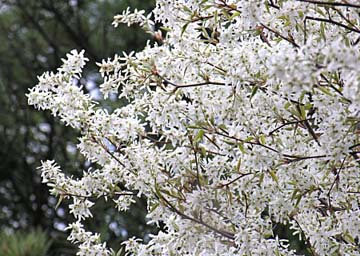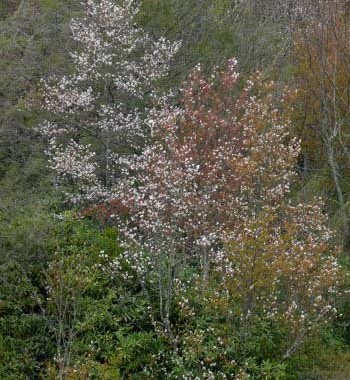 The peeper is a true herald of spring. The temperature’s got to warm up to 50 degrees before it will peep.
A heap of folks confuse the peeper with the true tree toad or tree frog. But the tree frog doesn’t make an appearance until late May or June.
By that time the peeper has put away its pipes until another spring.
As a matter of fact, the spring peeper pipes only about three or four weeks and then goes silent.
The peeper is classified as an animal. It has a big voice and a small body. It ranges in length from three-quarters of an inch to an inch and a half.
But what it lacks in size it makes up for in voice. Its shrill peeping can be heard for half a mile. Yet, unless you see him inflating his bubble-throat, you can scarcely see a peeper three feet away.
To many a mountain man sapped in spirit by a long winter of ice and snow and cold, there is nothing so beautifully welcome as the voice of the peeper proclaiming that spring has come again.
And along with the peeper chorus comes the bloom of the sarvicetree.
Botanists claim the tree got its name from the fruit it bears. They point out that the word is a transformation of the “sorbus” given by the Romans to a related kind of fruit.
Be that as it may, there’s a story they tell here in the mountains to explain how the sarvicetree came by its name, and it had nothing to do with Latin.
And whether it’s true or not really makes little difference.
But many an old-timer regards it true as Scripture.
After all, it’s what their grandsires told them, and their grandsires were not ones to pass on untruths.
This is what they said:
Back when folks were opening up the wilderness and putting down their roots, the hand of woman was still a stranger to the soil.
As cabins were grooved together and the land cleared, the womenfolks planted their flower seeds and waited for blooming time.
But while they waited they looked to the appearance of wild flowers for their funeral wreaths and wedding decorations.
But in a land where winter was long and spring came late the wild flowers were late in coming, too.
The womenfolks who came first, who came and settled between the flowering seasons, were the ones to notice the spring-heralding flowers of the high-mountain forest trees for which they had no names.
They gathered them and carried them to church services and funeral services.
And because these trees provided flowers for the services they caIled them “sarvis,” which was to say service.
Thus it was that the word caught on and came to stand for spring’s first blooming tree in the mountains.
The peeper is a true herald of spring. The temperature’s got to warm up to 50 degrees before it will peep.
A heap of folks confuse the peeper with the true tree toad or tree frog. But the tree frog doesn’t make an appearance until late May or June.
By that time the peeper has put away its pipes until another spring.
As a matter of fact, the spring peeper pipes only about three or four weeks and then goes silent.
The peeper is classified as an animal. It has a big voice and a small body. It ranges in length from three-quarters of an inch to an inch and a half.
But what it lacks in size it makes up for in voice. Its shrill peeping can be heard for half a mile. Yet, unless you see him inflating his bubble-throat, you can scarcely see a peeper three feet away.
To many a mountain man sapped in spirit by a long winter of ice and snow and cold, there is nothing so beautifully welcome as the voice of the peeper proclaiming that spring has come again.
And along with the peeper chorus comes the bloom of the sarvicetree.
Botanists claim the tree got its name from the fruit it bears. They point out that the word is a transformation of the “sorbus” given by the Romans to a related kind of fruit.
Be that as it may, there’s a story they tell here in the mountains to explain how the sarvicetree came by its name, and it had nothing to do with Latin.
And whether it’s true or not really makes little difference.
But many an old-timer regards it true as Scripture.
After all, it’s what their grandsires told them, and their grandsires were not ones to pass on untruths.
This is what they said:
Back when folks were opening up the wilderness and putting down their roots, the hand of woman was still a stranger to the soil.
As cabins were grooved together and the land cleared, the womenfolks planted their flower seeds and waited for blooming time.
But while they waited they looked to the appearance of wild flowers for their funeral wreaths and wedding decorations.
But in a land where winter was long and spring came late the wild flowers were late in coming, too.
The womenfolks who came first, who came and settled between the flowering seasons, were the ones to notice the spring-heralding flowers of the high-mountain forest trees for which they had no names.
They gathered them and carried them to church services and funeral services.
And because these trees provided flowers for the services they caIled them “sarvis,” which was to say service.
Thus it was that the word caught on and came to stand for spring’s first blooming tree in the mountains.
 And with the blooming of the sarvicetrees there was the voice of the peeper.
Both proclaimed that spring had come to the mountains.
And now, as then, the voice of the peeper is heard and the sarvicetrees are coming to bloom.
John Parris
And with the blooming of the sarvicetrees there was the voice of the peeper.
Both proclaimed that spring had come to the mountains.
And now, as then, the voice of the peeper is heard and the sarvicetrees are coming to bloom.
John ParrisMountain Bred, Tales by John Parris © Copyright 1967 - John Parris
